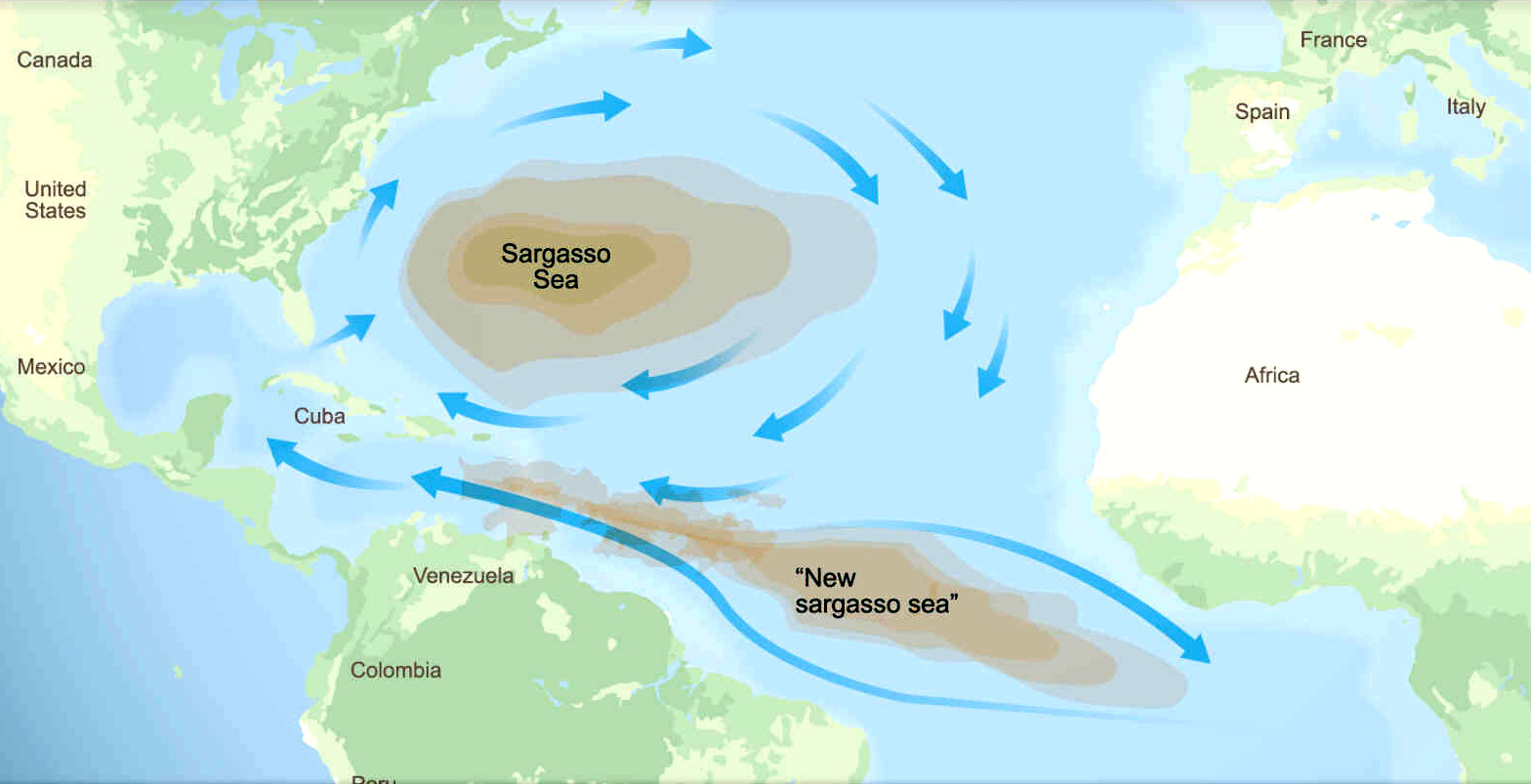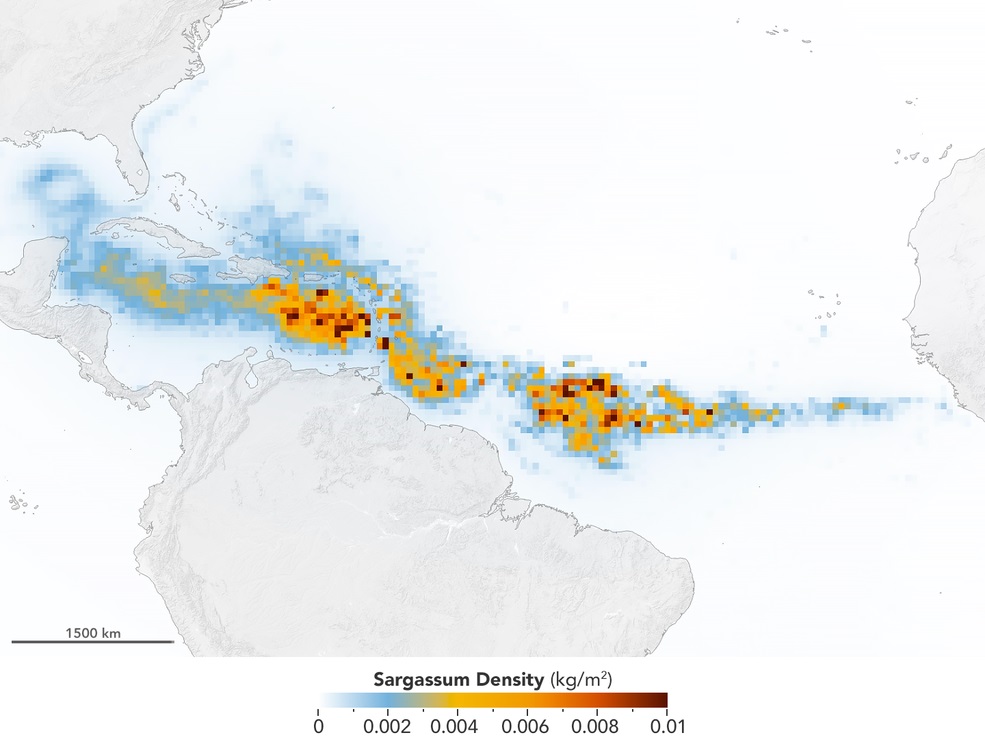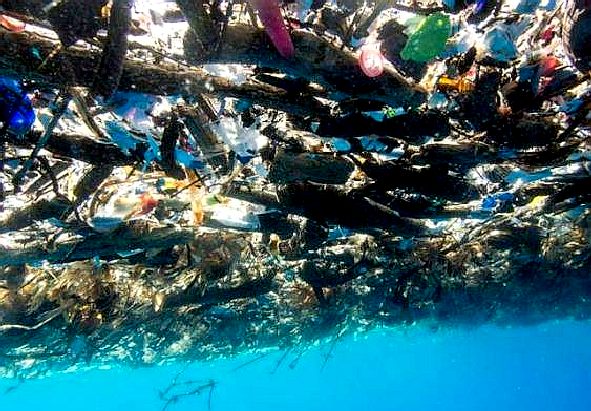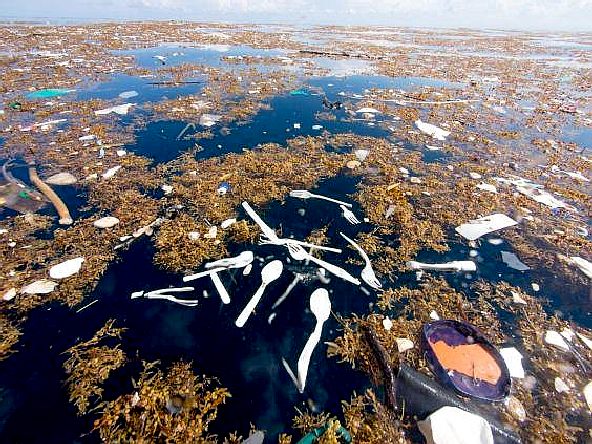|
SARGASSUM BELTS - COMPUTER SIMULATIONS
Please use our A-Z to navigate this site or return HOME
SARGASSUM - The giant brown seaweed, having shown that it can spread from North to South Atlantic oceans, could spread to the Indian and Pacific oceans as a potentially invasive species. The proof of which (as a theory) is satellite pictures, and changing wind states. The spread witnessed here, could just as easily migrate between oceans, and thence to the bays and seas within those oceans.
We are concerned that with the oceans warming at a faster rate than predicted, and with the spill over of sargassum from the previously contained Sargasso Sea in the North Atlantic, to create an Atlantic Equatorial sargassum gyre, that it is almost inevitable, and we might expect to see a South Atlantic sargassum gyre in the not too distant future. The notion is that from that point on, with the Indian and Pacific oceans also warming at the same rate [if that is a factor], spillage around the Cape of Good Hope and eventually, Cape Horn, could become a distinct possibility, bypassing the Australian Capes (Leeuwin and Howe), with an Indonesian belt, since the Southern Ocean is probably inhospitable to sargassum.
COMPUTER SIMULATIONS & MECHANICAL CONTAINMENT DEVICES
That all depends on temperature rise of seawater, combined with nutrient supply, and circulating currents, including winds. All of which is measurable, for variable algorithmic computer simulations. As has been performed on the influx to the Caribbean Sea, via the equatorial Atlantic gyre, by scientists at the University of South Florida in St. Petersburg's College of Marine Science, who used NASA satellite observations to discover and document the largest bloom of macroalgae. Others used Global Hybrid Coordinate Ocean Model surface currents (HYCOM) (Chassignet et al., 2007) and National Centers for Environmental Prediction Reanalysis (NCEP), in their simulations.
But nobody has yet created a computer model of a SeaVax Calypso or Sargasso, kind of ocean harvester, to determine if such a concept could control volume escalation, before they grow to be profusely irrepressible. Indeed such simulations may help develop such concepts in terms of capacity and operations, that they might actually contain the crisis, preventing a future worldwide state of emergency. Where, prevention is better than cure.
Since, this is a manmade phenomenon.
ABSTRACT -
SIMULATING
TRANSPORT PATHWAYS OF PELAGICC SARGASSUM FROM THE EQUATORIAL
ATLANTIC INTO THE CARIBBEAN SEA 2018
Here, we present results from synthetic particle tracking experiments that characterize the interannual and seasonal dynamics of ocean currents and winds likely to influence the transport of Sargassum from the Equatorial Atlantic into the Caribbean Sea. Our findings suggest that Sargassum present in the western Equatorial Atlantic (west of longitude 50°W) has a high probability of entering the Caribbean Sea within a year’s time. Transport routes include the Guiana Current, North Brazil Current Rings, and the North Equatorial Current north of the North Brazil Current Retroflection. The amount of Sargassum following each route varies seasonally.
This has important implications for the amount of time it takes Sargassum to reach the Caribbean Sea. By weighting particle transport predictions with Sargassum concentrations at release sites in the western Equatorial Atlantic, our simulations explain close to 90% of the annual variation in observed Sargassum abundance entering the Caribbean Sea. Additionally, results from our numerical experiments are in good agreement with observations of variability in the timing of Sargassum movement from the Equatorial Atlantic to the Caribbean, and observations of the spatial extent of Sargassum occurrence throughout the Caribbean. However, this work also highlights some areas of uncertainty that should be examined, in particular the effect of “windage” and other surface transport processes on the movement of Sargassum.
Our results provide a useful launching point to predict Sargassum beaching events along the Caribbean islands well in advance of their occurrence and, more generally, to understand the movement ecology of a floating ecosystem that is essential habitat to numerous marine species.
AUTHORS: Nathan F. Putman Gustavo J. Goni Lewis J. Gramer Chuanmin Hu Elizabeth M. Johns Joaquin Trinanes Mengqiu Wang
NASA SATELLITES FIND BIGGEST SEAWEED BLOOM IN THE WORLD 8 JULY 2019
LIKELY STUDY AREAS:
Atlantic - North & South Equatorial Banda Ceram Molucca & Timor Seas Pacific Ocean - North & South, Equatorial Belt (Costa Rica, Ecuador, Panama regions)
Seas and oceans in these latitudes could become inundated with sargassum (macro algae) if the rafts of floating seaweed manage to navigate less hospitable barriers, such as colder regions. Which at the moment, Cape Horn and the Cape of Good Hope appear to be barriers to invasion.
PLASTIC TIDE - These amazing pictures of a giant plastic tide were taken by Caroline Power. Please note how plastic and sargassum intertwine, creating a separation problem.
LINKS & REFERENCE
https://gmd.copernicus.org/articles/14/4069/2021/gmd-14-4069-2021.html https://www.nasa.gov/feature/goddard/2019/nasa-satellites-find-biggest-seaweed-bloom-in-the-world https://gmd.copernicus.org/articles/14/4069/2021/gmd-14-4069-2021.html https://www.nasa.gov/feature/goddard/2019/nasa-satellites-find-biggest-seaweed-bloom-in-the-world
This website is provided on a free basis as a public information service. copyright © Cleaner Oceans Foundation Ltd (COFL) (Company No: 4674774) August 2022. Solar Studios, BN271RF, United Kingdom. COFL is a charity without share capital. The names Amphimax™ RiverVax™ and SeaVax™ are trademarks.
|






